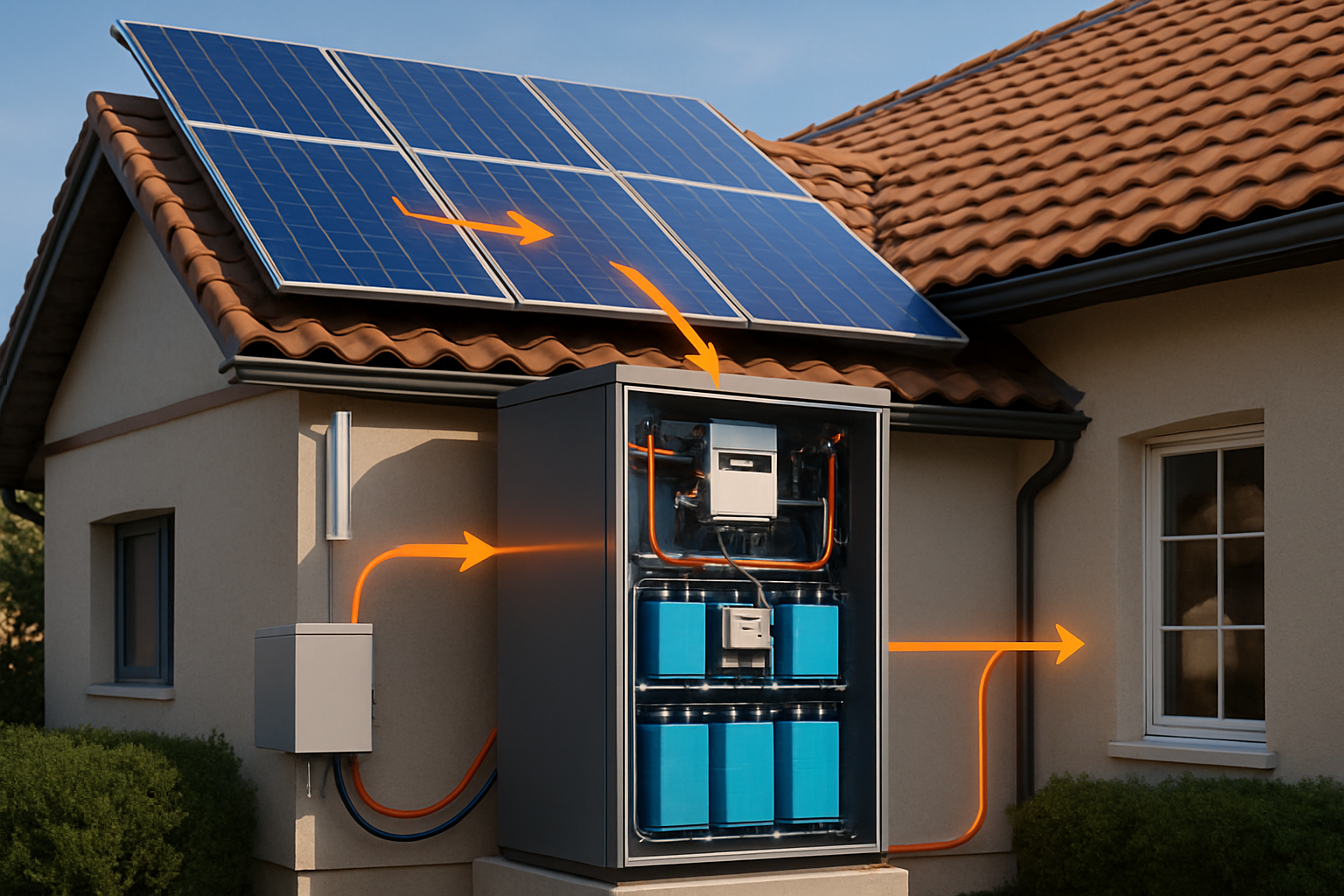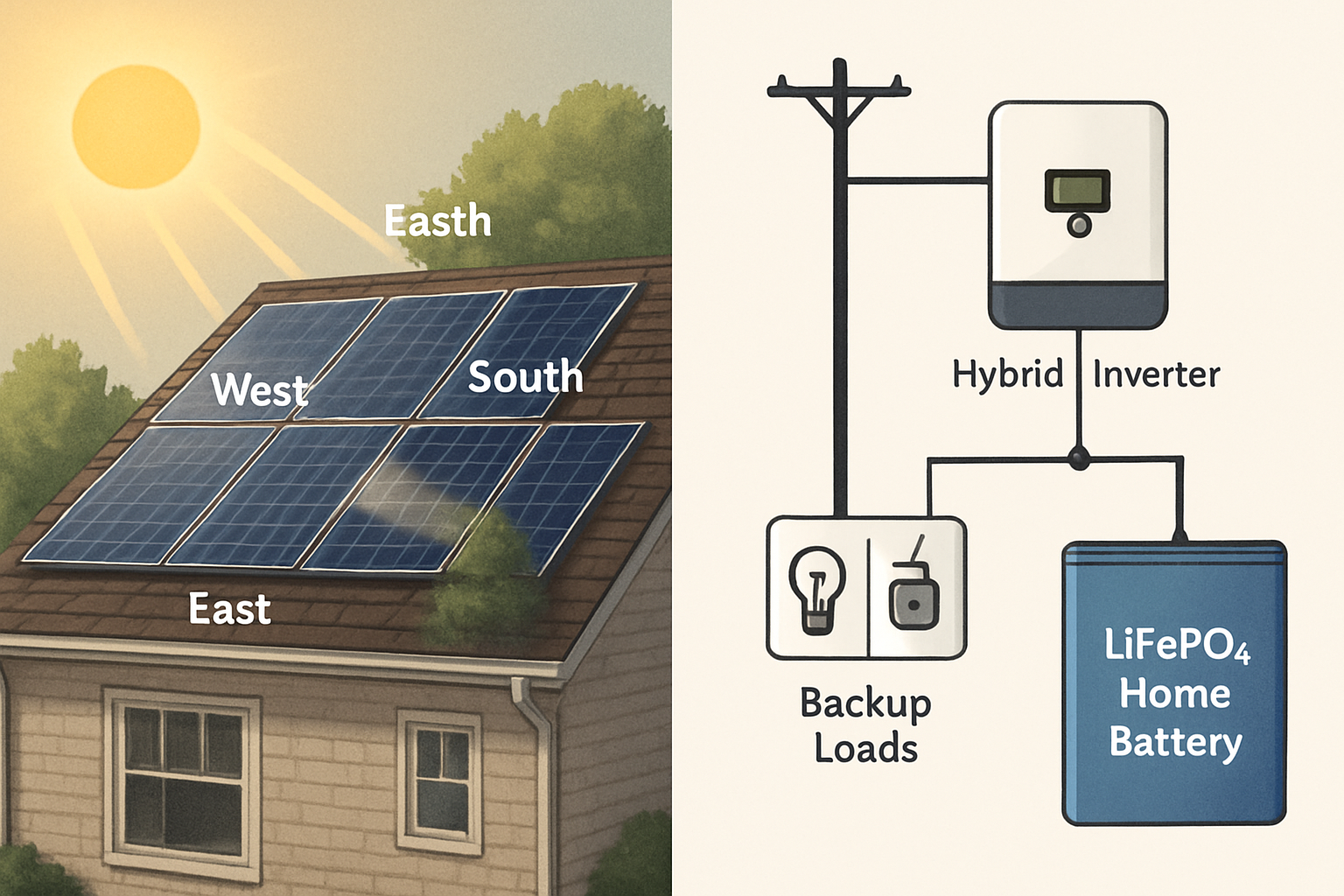Why this case matters
A tree-lined property often scares homeowners away from solar. Shade cuts output and creates mismatch between panels. This real project shows how microinverters and an Energy Storage System (ESS) can turn a “maybe” site into a solid fit for solar. It also shows the checks you can run to size expectations and avoid surprises.

Site snapshot: real constraints on a shady lot
Home profile:
- All-electric home, annual use ~10–11 MWh. The EIA reports a similar average for U.S. households.
- East–west gable roof, 22° pitch, limited south area.
- Deciduous trees cause partial shade. Morning shade on east roof, afternoon shade on west. 10–40% of modules affected in any hour.
- Time-of-use pricing with a 5–9 p.m. peak. Intermittent outages during summer storms.
Design goals:
- Maximize annual yield despite moving shade.
- Boost self-consumption and reduce exports during midday.
- Provide several hours of backup for critical loads.
Policy and technical context supports the choices made here. According to the IEA Next-Generation Wind and Solar Power, east–west layouts can expand rooftop opportunities and flatten output, while batteries paired with distributed PV raise self-consumption and reduce reverse power flows. The IRENA Electricity Storage Valuation Framework also highlights storage value from energy shifting, peak shaving, and resilience. See Energy.gov’s solar pages for homeowner-focused resources on PV and storage safety and benefits.
Design rationale: microinverters + ESS on a shady roof
Array layout and orientation
We used an east–west array of 18 modules at 400 W each. Total DC capacity: 7.2 kW. East–west helps spread production across the day. It also fits more panels where south-facing surface is scarce. The orientation aligns with IEA’s observation that non-equator-facing roofs can increase the space available for PV (IEA).
Why microinverters for Shaded Lot Solar
Shade seldom hits every panel the same way. With a single string inverter, the lowest-producing panel drags down its string. Microinverters place maximum power point tracking (MPPT) at each module. That isolates panel-level shade and mismatch. In practice, this often recovers 5–25% of energy on partially shaded roofs compared with a single MPPT string system. Recovery depends on shade pattern, roof planes, and array length.
Other benefits:
- Module-level monitoring for faster O&M.
- Rapid shutdown compliance for rooftop safety (check local code).
- Smaller failure domain: a single device issue affects only one panel.
Energy Storage System (ESS) selection
The home uses a 10 kWh LiFePO4 battery paired with a hybrid inverter. Usable capacity assumed at 9.5 kWh. Typical round-trip efficiency for LiFePO4 systems sits around 88–94% at residential scale. The goal is to shift midday solar into the evening peak and provide backup for critical loads. As noted by IEA, storage with distributed PV helps raise self-consumption and reduce grid stress. IRENA details stacking value streams, including peak shaving and resilience.
Performance: results after the upgrade
Modeled production and self-consumption
Assumptions use a temperate U.S. location with 4.7–5.0 peak sun hours, typical losses, and actual tree shading measured on-site. DC/AC ratio is set to 1.15 to limit clipping while keeping inverters loaded. The IEA notes rising DC/AC ratios can add value by smoothing output.
- Annual production with string inverter (single MPPT) under site shade: ~8,000 kWh.
- Annual production with microinverters under same shade: ~8,900 kWh (+11%).
- Self-consumption without ESS: ~35–40% (typical for PV-only homes on TOU).
- Self-consumption with 10 kWh ESS: ~65–75%, driven by evening discharge.
Backup math: with 9.5 kWh usable and 90% RTE net of conversion, ~8.5 kWh reaches loads. A 3 kW critical-load panel can run for about 2.8 hours, longer at lighter loads.
Shade-aware hardware comparison
| Metric | String Inverter (single MPPT) | Microinverters |
|---|---|---|
| Annual energy under partial shade | ~8,000 kWh | ~8,900 kWh (+11%) |
| Impact of a shaded module | Reduces string output | Isolated to that module |
| Monitoring granularity | String-level | Module-level |
| Rapid shutdown | Often via add-ons | Integrated in many models |
| Failure domain | String-wide | Single module |
Energy flow changes with ESS
- Midday surplus moves into 5–9 p.m. peak. This cuts peak imports by 60–90% depending on season.
- Exports fall, easing reverse power flows in the neighborhood circuit, consistent with IEA system-friendliness findings.
- Outage support covers lighting, networking, refrigeration, and small HVAC circulation.
Costs, savings, and valuation
Exact numbers vary by market and incentives. The method below helps you size the value.
- Energy yield value: microinverter uplift ~900 kWh/year. At $0.18/kWh average, that is ~$162/year.
- Time-shift value: charge 8 kWh/day and discharge during a $0.20/kWh peak vs $0.10/kWh off-peak. Gross spread ~$0.10 × 8 = $0.80/day. Net of ~10% losses, ~$0.72/day or ~$260/year (assuming 360 cycles).
- Resilience value: depends on your outage history and avoided spoilage or downtime. The IRENA framework treats resilience as a distinct, location-specific benefit.
Policy and program signals matter. Premiums that favor system-friendly output and self-consumption improve the case for storage. The IEA highlights such policy designs in its system-friendly VRE discussion. For technology background and homeowner resources, see Energy.gov.
Is your shady home a good fit? Quick checks
1) Map shade across the year
- Use drone photos or a site survey to record tree locations and heights.
- Check seasonal leaf cover. Winter sun can be strong with bare trees.
- Ask your installer for a module-level shade simulation.
2) Embrace east–west if south is limited
- East–west increases roof coverage and spreads production. The IEA notes this can expand rooftop PV potential.
- A moderate DC/AC ratio (e.g., 1.1–1.3) helps fill the inverter curve without heavy clipping.
3) Pick hardware that tolerates shade
- Microinverters or other module-level power electronics handle mismatch well.
- Ask for rapid shutdown compliance and panel-level monitoring.
4) Right-size storage
- Start with 0.8–1.5 kWh of usable storage per kW of PV for TOU shifting. Adjust for your evening load.
- For outage support, tally critical loads in watts and hours. Multiply to find kWh needs, then add headroom.
- LiFePO4 chemistry offers stable cycling and high round-trip efficiency. Our firm focuses on LiFePO4 cells, hybrid inverters, and integrated ESS for homes and off-grid sites.
Case roll-up
| Item | Baseline (PV-only, string) | Final (Microinverters + 10 kWh ESS) |
|---|---|---|
| Array size / layout | 7.2 kW, east–west | 7.2 kW, east–west |
| Annual PV output | ~8,000 kWh | ~8,900 kWh |
| Self-consumption | ~35–40% | ~65–75% |
| Peak import reduction (5–9 p.m.) | Low | 60–90% |
| Backup capability | None | ~3 kW critical loads for ~2.8 hours |
What this means for Home Solar Suitability
Shade does not automatically disqualify a roof. Microinverters claw back production lost to moving shade. East–west orientation increases usable roof area and flattens the curve, in line with IEA insights. An ESS then moves energy to the hours that matter and adds backup.
For deeper technical context on solar thermal and storage pathways in broader energy systems, see IEA’s Solar Energy Perspectives. While this case centers on PV + batteries, the cross-cutting point stands: storage paired with solar improves system value.
Key takeaways
- Shaded Lot Solar can succeed with module-level power electronics.
- Microinverters improved annual yield here by ~11% under partial shade.
- Energy Storage Systems (ESS) lifted self-consumption to ~65–75% and cut evening imports.
- East–west layouts expand rooftop potential and smooth output, as noted by the IEA.
- Use utility rates, outage history, and load profiles to size storage. The IRENA framework helps frame total value.
Disclaimer: This content is for general information only and does not constitute legal, financial, or engineering advice. Check local codes, interconnection rules, and incentives.





Leave a comment
All comments are moderated before being published.
This site is protected by hCaptcha and the hCaptcha Privacy Policy and Terms of Service apply.